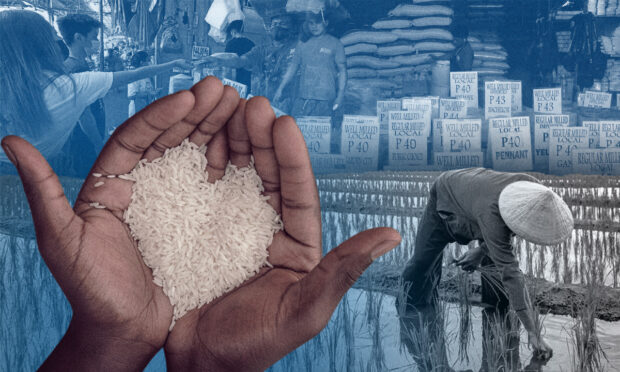Easing rice import tariffs better option than price caps – FEF

COMPOSITE IMAGE INQUIRER STOCK PHOTO
MANILA, Philippines — The Foundation for Economic Freedom (FEF) has called on the Marcos administration to temporarily lift or at least cut import tariffs on rice to check surging prices of the staple grain and avert a possible “full-blown rice crisis.”
FEF said lifting or reducing the 35-percent import tariff provided under the rice tariffication law was a better option than imposing a price cap of P41 a kilogram on regular-milled rice and P45 a kilo on well-milled rice, in accordance with Executive Order No. 39 made public on Friday and set to take effect on Sept. 5.
The think tank warned that setting a price ceiling would harm Filipino consumers and farmers alike as well as the entire domestic economy, with poorer Filipinos likely to bear the brunt of the consequences.
According to FEF, the price cap will harm consumers because it will drive supply away from the market, fuel a black market for rice, and cause traders to cheat consumers by mixing inferior broken rice with regular and well-milled rice to earn a better profit.
The price cap will also give traders a reason to hoard rice stocks and wait for higher prices as the price ceiling under EO 39 is below their buying and selling prices, FEF added.
Aggravation
“Lower-income consumers in particular will suffer when regular milled rice becomes less available in markets at a controlled price and is passed on as well-milled rice by traders,” the group said in a statement.
FEF counts among its members top economists, former and present Cabinet secretaries and undersecretaries, leading figures in the academe, respected columnists and opinion makers, and prominent members in the business and finance community.
Some of them are former World Bank resident representative Thomas Allen, National Scientist Raul Fabella, former Prime Minister Cesar E.A. Virata, and former Socioeconomic Planning Secretary Gerardo Sicat who serve in the FEF board of advisers.
FEF sees price ceilings as likewise harmful to farmers because traders will use the price cap to justify lowering their buying prices for palay or simply refuse to buy palay from the farmers as they will lose money if farm-gate prices of palay are higher than the cap.
“The price cap will harm the entire economy because it will not be effective in solving the demand-supply gap and arresting increasing food price inflation,” the group said. “It will only aggravate the current tight rice supply situation into a full-blown rice crisis.”
Given this, the group called on the government to lift or reduce import tariffs for rice from 35 percent to 10 percent to arrest the surging price of rice. They said lower or no tariffs on rice imports will quickly lead to lower rice prices.
Unlimited entry
“The government can afford to lower rice tariffs because the mandatory P10 billion allocation for the Rice Competitiveness Enhancement Fund (RCEF) as stipulated by the rice tariffication law, has already been achieved,” FEF said.
Signed on Feb. 14, 2019, by former President Rodrigo Duterte, the rice tariffication law allowed traders to bring in an unlimited volume of rice as long as these were slapped with a tariff of 35 percent if coming from members of the Association of Southeast Asian Nations and 50 percent for non-Asean states.
“The government may restore the tariff rates back to 35 percent when the demand and supply situation stabilizes and if the onset of the harvest season results in falling rice prices,” it added.
According to the price monitoring of the Department of Agriculture, local regular milled rice surged to P42 to P55 a kilo on Sept. 1 from P35 to P40 on Jan. 12 this year and P38 on Sept. 1 last year. Well-milled rice, on the other hand, climbed to P47 to P57 a kilo from P38 to P44 on Jan. 12 this year and P40 in the same period last year.
Surging rice prices have been cited as a major factor behind the acceleration in inflation in August, ending six straight months of decline in the average prices of basic goods and services that households commonly purchase.
Aid program
Meanwhile, the Department of Trade and Industry (DTI) said an aid program aimed at extending support to small rice traders and retailers that will be affected by EO 39 was “in the works.”
Trade Assistant Secretary Agaton Uvero acknowledged that small traders who bought their stocks at higher prices are expected to lose money because of the price caps.
Uvero said in a statement the government is looking at possible support that can be extended to them so they could avoid bankruptcy.
Still, Uvero said the DTI believes that previous commodity price increases had brought fortune to small businesses, and they already “had a windfall and should sacrifice” at this time for the interest of the general public.